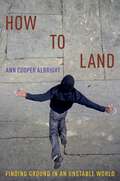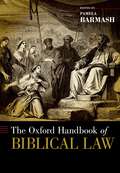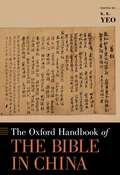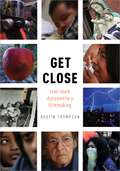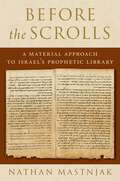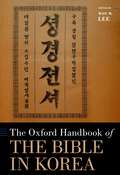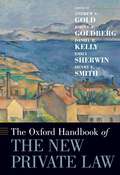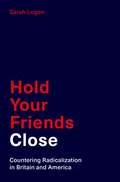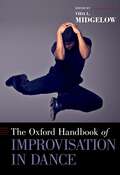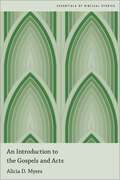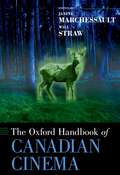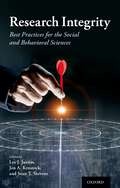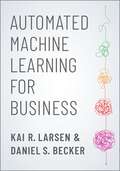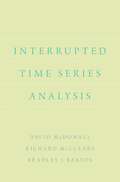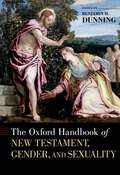- Table View
- List View
HOW TO LAND C: Finding Ground in an Unstable World
by Ann Cooper AlbrightHow to Land: Finding Ground in an Unstable World foregrounds the importance of embodiment as a means of surviving the disorientation of our twenty-first century world. Linking somatics and politics, author Ann Cooper Albright argues that a renewed attention to gravity as both a metaphoric sensibility and a physical experience can help transform moments of personal disorientation into an opportunity to reflect on the important relationship between individual resiliency and communal responsibility. Long one of the nation's preeminent thinkers in dance studies, Albright asks how contemporary bodies are affected by repeated images of falling bodies, bombed-out buildings, and displaced peoples, as well as recurring evocations of global economies and governments in discursive free fall or dissolution. What kind of fear gets lodged in connective tissue when there is an underlying anxiety that certain aspects of our world are in danger of falling apart? To answer this question, she draws on analyses of perception from cognitive studies, tracing the discussions of meaning, body and language through the work of Sara Ahmed, Jean-Luc Nancy, and Shaun Gallagher, among others. In addition, she follows the past decade of debate in contemporary media concerning the implications of the weightless and two-dimensional social media exchanges on structures of attention and learning, as well as their effect on the personal growth and socialization of a generation of young adults. Each chapter interweaves discussions of movement actions with their cultural implications, documenting specific bodily experiences and then tracing their ideological ripples out through the world.
The Oxford Handbook of Biblical Law (Oxford Handbooks)
by Pamela BarmashMajor innovations have occurred in the study of biblical law in recent decades. The legal material of the Pentateuch has received new interest with detailed studies of specific biblical passages. The comparison of biblical practice to ancient Near Eastern customs has received a new impetus with the concentration on texts from actual ancient legal transactions. The Oxford Handbook of Biblical Law provides a state of the art analysis of the major questions, principles, and texts pertinent to biblical law. The thirty-three chapters, written by an international team of experts, deal with the concepts, significant texts, institutions, and procedures of biblical law; the intersection of law with religion, socio-economic circumstances, and politics; and the reinterpretation of biblical law in the emerging Jewish and Christian communities. The volume is intended to introduce non-specialists to the field as well as to stimulate new thinking among scholars working in biblical law.
The Oxford Handbook of the Bible in China (Oxford Handbooks)
Is the Bible an ancient text, a mere relic of the past? Is the Bible a "Western" product, irrelevant to the "East"? Can the Bible be imagined as a living text for twenty-first century China? The Oxford Handbook of the Bible in China provides surprising answers and discoveries related to the Bible and its place in China over the last thirteen hundred years. Forty-seven essays address the translation of the Bible into China's languages and dialects, expression of the Bible in Chinese literary and religious contexts, Chinese biblical interpretations and methods of reading, and the reception of the Bible in the institutions and arts of China. Each essay consists of a comprehensive yet concise treatment set in a historical frame on topics as wide-ranging as: the first Chinese Bibles, Chinese Nestorian Christianity, Bibles of minority nationalities, Sino-Christian theology, printed illustrations of the Gospel in China, the Bible and Chinese films, Chinese calligraphy and the biblical texts, Chinese Classics and the Bible, and Chinese society and politics. This expansive and unique volume presents insightful, succinct, and provocative evidence about and interpretations of encounters between the Bible and China for centuries past, continuing into the present, and likely prospects for the future.
The Oxford Handbook of the Bible in China (Oxford Handbooks)
by K. K. YeoIs the Bible an ancient text, a mere relic of the past? Is the Bible a "Western" product, irrelevant to the "East"? Can the Bible be imagined as a living text for twenty-first century China? The Oxford Handbook of the Bible in China provides surprising answers and discoveries related to the Bible and its place in China over the last thirteen hundred years. Forty-seven essays address the translation of the Bible into China's languages and dialects, expression of the Bible in Chinese literary and religious contexts, Chinese biblical interpretations and methods of reading, and the reception of the Bible in the institutions and arts of China. Each essay consists of a comprehensive yet concise treatment set in a historical frame on topics as wide-ranging as: the first Chinese Bibles, Chinese Nestorian Christianity, Bibles of minority nationalities, Sino-Christian theology, printed illustrations of the Gospel in China, the Bible and Chinese films, Chinese calligraphy and the biblical texts, Chinese Classics and the Bible, and Chinese society and politics. This expansive and unique volume presents insightful, succinct, and provocative evidence about and interpretations of encounters between the Bible and China for centuries past, continuing into the present, and likely prospects for the future.
Get Close: Lean Team Documentary Filmmaking
by Rustin ThompsonA refreshing new practical approach to documentary filmmaking, Get Close: Lean Team Documentary Filmmaking equips new and veteran filmmakers with the knowhow to make artistically rewarding documentaries for less money, less hassle, and less time. Author and veteran filmmaker Rustin Thompson shows that by stripping away, sidestepping, or reassessing the entrenched industry hurdles-long waits for funding, the unwieldy crews, the unnecessary gear, the gauntlet of film festivals, pitch forums, and distribution networks-filmmakers can move quickly from idea to execution to finished film. Throughout the book, Thompson demystifies and de-clutters the way docs are produced today, illustrating the use of a few simple and accessible tools and techniques while still engaging with the aesthetic possibilities of the medium, its creative opportunities and its satisfying rewards of giving back to the world. Using the essential lessons in Get Close, filmmakers will learn to eliminate physical and financial barriers between themselves and their subject matter, ultimately leading them to tell more artful, illuminating stories and find the joy in documentary filmmaking.
GET CLOSE C: Lean Team Documentary Filmmaking
by Rustin ThompsonA refreshing new practical approach to documentary filmmaking, Get Close: Lean Team Documentary Filmmaking equips new and veteran filmmakers with the knowhow to make artistically rewarding documentaries for less money, less hassle, and less time. Author and veteran filmmaker Rustin Thompson shows that by stripping away, sidestepping, or reassessing the entrenched industry hurdles-long waits for funding, the unwieldy crews, the unnecessary gear, the gauntlet of film festivals, pitch forums, and distribution networks-filmmakers can move quickly from idea to execution to finished film. Throughout the book, Thompson demystifies and de-clutters the way docs are produced today, illustrating the use of a few simple and accessible tools and techniques while still engaging with the aesthetic possibilities of the medium, its creative opportunities and its satisfying rewards of giving back to the world. Using the essential lessons in Get Close, filmmakers will learn to eliminate physical and financial barriers between themselves and their subject matter, ultimately leading them to tell more artful, illuminating stories and find the joy in documentary filmmaking.
Before the Scrolls: A Material Approach to Israel's Prophetic Library
by Nathan MastnjakBefore the Scrolls traces the media history of the biblical prophetic corpus to propose a material approach to biblical literature. Although scholars understand that the material of composition was the scroll rather than the codex, they persist in imagining the form as a single textual object. This assumption pervades centuries of scholarship and drives many of the questions asked about biblical composition. Nathan Mastnjak raises the question of the original physical format of biblical texts and argues that many of the literary works that would eventually become the Bible's prophetic books were not written initially as books. Isaiah, Jeremiah, and Ezekiel were originally composed on loosely organized collections of multiple short papyrus scrolls and sheets. Though rarely considered in scholarship, the realia of a text's form, format, production, and material substance have a profound influence on the meaning of the text. Unlike works committed to single book-scrolls, these collections did not have predetermined orders of reading and were susceptible to multiple arrangements. Only in the Hellenistic era were these compositions edited, organized, and copied into single volume book-scrolls such as those known from the Dead Sea. By investigating the relationship between form and meaning and the transition from the collection to the book, Mastnjak suggests novel solutions to classic problems in biblical scholarship, such as the relationships between the MT and LXX of Jeremiah and that between First and Second Isaiah. The failure to account for the materiality of the prophetic corpus has led scholarship to occasionally ask the wrong questions of these compositions and has blinded it to the vital role that Hellenistic bookmakers played in the creation of the Bible as we know it. Reconceiving much Judean literature on a collection-model rather than book-model has significant implications for our understanding of how the Bible itself was composed and read.
Before the Scrolls: A Material Approach to Israel's Prophetic Library
by Nathan MastnjakBefore the Scrolls traces the media history of the biblical prophetic corpus to propose a material approach to biblical literature. Although scholars understand that the material of composition was the scroll rather than the codex, they persist in imagining the form as a single textual object. This assumption pervades centuries of scholarship and drives many of the questions asked about biblical composition. Nathan Mastnjak raises the question of the original physical format of biblical texts and argues that many of the literary works that would eventually become the Bible's prophetic books were not written initially as books. Isaiah, Jeremiah, and Ezekiel were originally composed on loosely organized collections of multiple short papyrus scrolls and sheets. Though rarely considered in scholarship, the realia of a text's form, format, production, and material substance have a profound influence on the meaning of the text. Unlike works committed to single book-scrolls, these collections did not have predetermined orders of reading and were susceptible to multiple arrangements. Only in the Hellenistic era were these compositions edited, organized, and copied into single volume book-scrolls such as those known from the Dead Sea. By investigating the relationship between form and meaning and the transition from the collection to the book, Mastnjak suggests novel solutions to classic problems in biblical scholarship, such as the relationships between the MT and LXX of Jeremiah and that between First and Second Isaiah. The failure to account for the materiality of the prophetic corpus has led scholarship to occasionally ask the wrong questions of these compositions and has blinded it to the vital role that Hellenistic bookmakers played in the creation of the Bible as we know it. Reconceiving much Judean literature on a collection-model rather than book-model has significant implications for our understanding of how the Bible itself was composed and read.
The Oxford Handbook of the Bible in Korea (Oxford Handbooks)
The phenomenon of South Korean Christianity is, in a word, remarkable. In less than 250 years, 29% of South Korea's population adheres to Christianity, a staggering 71% of Korean Americans identify as Christian, and the powerful zeal of Korean Christians to spread the Gospel's influence in South Korea already overshadows other established religious groups (i.e. Buddhism, Confucianism). This phenomenon-particularly the rapid growth and unique interpretation of Christianity among Koreans around the world-is intimately and inextricably tied to how Koreans appropriated the Bible in their religio-cultural and socio-political milieu from the 18th century onward. Less noted and understood, however, is the tapestry of Korean biblical interpretation that emerged from being missionized, colonized, divided, and globalized. These influences reflect a distinctive Korean-ness of biblical interpretation that relates closely to Korean perceptions of divine liberating intervention, and the Korean diaspora that seeks to move beyond oppression. This Handbook offers a comprehensive overview on how the Bible has been used by faith communities in Korea and the Korean diaspora over two centuries. In this volume, noted theologically diverse scholars present representative thinking on creative inculturations of the Bible in Korea. Some conservatively align with received western orthodoxy. Others have a sense of complementarity that informs distinctive accents of Korean Christianity, the long-standing religious traditions of Korea, the diversity of Korea's global diaspora, and the learning of non-Koreans attentive to the impact of the Bible in Korea. Together, this volume presents an exquisite tapestry of Korean biblical interpretation in the making.
The Oxford Handbook of the Bible in Korea (Oxford Handbooks)
by Won W. LeeThe phenomenon of South Korean Christianity is, in a word, remarkable. In less than 250 years, 29% of South Korea's population adheres to Christianity, a staggering 71% of Korean Americans identify as Christian, and the powerful zeal of Korean Christians to spread the Gospel's influence in South Korea already overshadows other established religious groups (i.e. Buddhism, Confucianism). This phenomenon-particularly the rapid growth and unique interpretation of Christianity among Koreans around the world-is intimately and inextricably tied to how Koreans appropriated the Bible in their religio-cultural and socio-political milieu from the 18th century onward. Less noted and understood, however, is the tapestry of Korean biblical interpretation that emerged from being missionized, colonized, divided, and globalized. These influences reflect a distinctive Korean-ness of biblical interpretation that relates closely to Korean perceptions of divine liberating intervention, and the Korean diaspora that seeks to move beyond oppression. This Handbook offers a comprehensive overview on how the Bible has been used by faith communities in Korea and the Korean diaspora over two centuries. In this volume, noted theologically diverse scholars present representative thinking on creative inculturations of the Bible in Korea. Some conservatively align with received western orthodoxy. Others have a sense of complementarity that informs distinctive accents of Korean Christianity, the long-standing religious traditions of Korea, the diversity of Korea's global diaspora, and the learning of non-Koreans attentive to the impact of the Bible in Korea. Together, this volume presents an exquisite tapestry of Korean biblical interpretation in the making.
The Oxford Handbook of the New Private Law (Oxford Handbooks)
The Oxford Handbook of the New Private Law reflects exciting developments in scholarship dedicated to reinvigorating the study of the broad field of private law. This field embraces the traditional common law subjects (property, contracts, and torts), as well as adjacent, more statutory areas, such as intellectual property and commercial law. It also includes important areas that have been neglected in the United States but are beginning to make a comeback. These include unjust enrichment, restitution, equity, and remedies more generally. "Private law" can also mean private law as a whole, which invites consideration of issues such as the public-private distinction, the similarities and differences between the various areas of private law, and the institutional framework supporting private law - including courts, arbitrators, and even custom. The New Private Law is an approach to these subjects that aims to bring a new outlook to the study of private law by moving beyond reductively instrumentalist policy evaluation and narrow, rule-by-rule, doctrine-by-doctrine analysis, so as to consider and capture how private law's various features fit and work together, as well as the normative underpinnings of these larger structures. This movement has begun resuscitating the notion of private law itself in the United States and has brought an interdisciplinary perspective to the more traditional, doctrinal approach prevalent in Commonwealth countries. The Handbook embraces a broad range of perspectives to private law - including philosophical, economic, historical, and psychological, to name a few - yet it offers a unifying theme of seriousness about the structure and content of private law. It will be an essential resource for legal scholars interested in the future of this important field.
The Oxford Handbook of the New Private Law (Oxford Handbooks)
by Emily Sherwin Andrew S. Gold Henry E. Smith John C.P. Goldberg Daniel B. KellyThe Oxford Handbook of the New Private Law reflects exciting developments in scholarship dedicated to reinvigorating the study of the broad field of private law. This field embraces the traditional common law subjects (property, contracts, and torts), as well as adjacent, more statutory areas, such as intellectual property and commercial law. It also includes important areas that have been neglected in the United States but are beginning to make a comeback. These include unjust enrichment, restitution, equity, and remedies more generally. "Private law" can also mean private law as a whole, which invites consideration of issues such as the public-private distinction, the similarities and differences between the various areas of private law, and the institutional framework supporting private law - including courts, arbitrators, and even custom. The New Private Law is an approach to these subjects that aims to bring a new outlook to the study of private law by moving beyond reductively instrumentalist policy evaluation and narrow, rule-by-rule, doctrine-by-doctrine analysis, so as to consider and capture how private law's various features fit and work together, as well as the normative underpinnings of these larger structures. This movement has begun resuscitating the notion of private law itself in the United States and has brought an interdisciplinary perspective to the more traditional, doctrinal approach prevalent in Commonwealth countries. The Handbook embraces a broad range of perspectives to private law - including philosophical, economic, historical, and psychological, to name a few - yet it offers a unifying theme of seriousness about the structure and content of private law. It will be an essential resource for legal scholars interested in the future of this important field.
Hold Your Friends Close: Countering Radicalization in Britain and America
by Sarah LoganWhen we think of counterterrorism we often think of coercive measures, including expanded policing powers, extraordinary rendition, increased jail sentences, and no-fly lists. Yet, several countries also use surprisingly "soft" methods to deal with the rising problem of homegrown extremism--from debate training and sports competitions to citizenship education and information campaigns. Given the violent aims of homegrown extremists, why do states opt for this softer approach? In Hold Your Friends Close, Sarah Logan provides the first exploration of counter-radicalization policy and homegrown extremism through a theoretical and historical lens. Logan contends that unlike traditional counterterrorism, counter-radicalization is generally informed by ideals of citizenship and allegiance to the state as a panacea for the violence of homegrown extremism. Because the radicals these policies target are not loyal to their own state, but rather to the idea of a non-state based political or religious community, winning them back to their "home" state is the primary aim of counter-radicalization efforts. While there are some basic similarities in approach across countries, there are important divergences too. Logan argues that this stems from different ideas about the nature of citizenship and national belonging. To that end, Logan compares the different approaches of the UK and US, showing how they differ in important ways despite a basic focus on solidifying the target subject's allegiance to their home state. Providing the first detailed policy history of counter-radicalization in the US and the UK, as well as a comprehensive overview of counter-radicalization policies globally, Hold Your Friends Close is an essential read for scholars and policymakers who work on terrorism and its sources.
Hold Your Friends Close: Countering Radicalization in Britain and America
by Sarah LoganWhen we think of counterterrorism we often think of coercive measures, including expanded policing powers, extraordinary rendition, increased jail sentences, and no-fly lists. Yet, several countries also use surprisingly "soft" methods to deal with the rising problem of homegrown extremism--from debate training and sports competitions to citizenship education and information campaigns. Given the violent aims of homegrown extremists, why do states opt for this softer approach? In Hold Your Friends Close, Sarah Logan provides the first exploration of counter-radicalization policy and homegrown extremism through a theoretical and historical lens. Logan contends that unlike traditional counterterrorism, counter-radicalization is generally informed by ideals of citizenship and allegiance to the state as a panacea for the violence of homegrown extremism. Because the radicals these policies target are not loyal to their own state, but rather to the idea of a non-state based political or religious community, winning them back to their "home" state is the primary aim of counter-radicalization efforts. While there are some basic similarities in approach across countries, there are important divergences too. Logan argues that this stems from different ideas about the nature of citizenship and national belonging. To that end, Logan compares the different approaches of the UK and US, showing how they differ in important ways despite a basic focus on solidifying the target subject's allegiance to their home state. Providing the first detailed policy history of counter-radicalization in the US and the UK, as well as a comprehensive overview of counter-radicalization policies globally, Hold Your Friends Close is an essential read for scholars and policymakers who work on terrorism and its sources.
The Oxford Handbook of Improvisation in Dance (Oxford Handbooks)
by Vida L. MidgelowFrom the dance floor of a tango club to group therapy classes, from ballet to community theatre, improvised dance is everywhere. For some dance artists, improvisation is one of many approaches within the choreographic process. For others, it is a performance form in its own right. And while it has long been practiced, it is only within the last twenty years that dance improvisation has become a topic of critical inquiry. With The Oxford Handbook of Improvisation in Dance, dancer, teacher, and editor Vida L. Midgelow provides a cutting-edge volume on dance improvisation in all its facets. Expanding beyond conventional dance frameworks, this handbook looks at the ways that dance improvisation practices reflect our ability to adapt, communicate, and respond to our environment. Throughout the handbook, case studies from a variety of disciplines showcase the role of individual agency and collective relationships in improvisation, not just to dancers but to people of all backgrounds and abilities. In doing so, chapters celebrate all forms of improvisation, and unravel the ways that this kind of movement informs understandings of history, socio-cultural conditions, lived experience, cognition, and technologies.
An Introduction to the Gospels and Acts (Essentials of Biblical Studies)
by Alicia D. MyersIntroducing the Gospels and Acts is not just about reading the first five books of the New Testament. It requires entering the first century Mediterranean world where the events in these writings happened. In this short book, Alicia D. Myers takes readers on a journey through the Gospels and Acts, introducing them to the world of Jesus of Nazareth and of the believers who composed and shared stories inspired by him. Myers provides overviews of context and major passages in each canonical work, and also introduces readers to the Apocryphal Gospels and Acts to demonstrate the larger phenomenon of early Christian writing. After situating readers in the literary context of the Gospels and Acts, Myers focuses on the writings themselves, giving basic historical background before digging more deeply into a chosen contextual theme for each work. These six themes include the politics and history of Roman Palestine, expressions of Second Temple Judaism, understandings of identity and human worth in the Roman world, hospitality, Hellenistic philosophies, and the process of canonizing the New Testament. Rather than shying away from difficult and often confusing elements of the Gospels and Acts, Myers invites readers to engage more deeply and situate themselves more fully in the strangeness and surprising familiarity of the Roman world. In this way, readers will see the continuing relevance of the Gospels and Acts for today and learn to be responsible readers of these works for years to come.
An Introduction to the Gospels and Acts (Essentials of Biblical Studies)
by Alicia D. MyersIntroducing the Gospels and Acts is not just about reading the first five books of the New Testament. It requires entering the first century Mediterranean world where the events in these writings happened. In this short book, Alicia D. Myers takes readers on a journey through the Gospels and Acts, introducing them to the world of Jesus of Nazareth and of the believers who composed and shared stories inspired by him. Myers provides overviews of context and major passages in each canonical work, and also introduces readers to the Apocryphal Gospels and Acts to demonstrate the larger phenomenon of early Christian writing. After situating readers in the literary context of the Gospels and Acts, Myers focuses on the writings themselves, giving basic historical background before digging more deeply into a chosen contextual theme for each work. These six themes include the politics and history of Roman Palestine, expressions of Second Temple Judaism, understandings of identity and human worth in the Roman world, hospitality, Hellenistic philosophies, and the process of canonizing the New Testament. Rather than shying away from difficult and often confusing elements of the Gospels and Acts, Myers invites readers to engage more deeply and situate themselves more fully in the strangeness and surprising familiarity of the Roman world. In this way, readers will see the continuing relevance of the Gospels and Acts for today and learn to be responsible readers of these works for years to come.
The Oxford Handbook of Canadian Cinema (Oxford Handbooks)
by Will Straw Janine MarchessaultThe chapters in The Oxford Handbook of Canadian Cinema present a rich, diverse overview of Canadian cinema. Responding to the latest developments in Canadian film studies, this volume takes into account the variety of artistic voices, media technologies, and places which have marked cinema in Canada throughout its history. Drawing on a range of established and emerging scholars from a range of disciplines, this volume will be useful to teachers, scholars, and to a general readership interested in cinema in Canada. Moving beyond the director-focused approach of much previous scholarship, this book is concerned with communities, institutions, and audiences for Canadian cinema at both national and international levels. The choice of subjects covered ranges from popular, genre cinema to the most experimental of artistic interventions. Canadian cinema is seen in its interaction with other forms of art-making and media production in Canada and at the international level. Particular attention has been paid to the work of Indigenous filmmakers, members of diasporic communities and feminist and LGBTQ artists. The result is a book attentive to the complex social and institutional contexts in which Canadian cinema is made and consumed.
Research Integrity: Best Practices for the Social and Behavioral Sciences
The primary goal of science is to "get it right," meaning that scientists seek to accurately document the world as it is. While erroneous conclusions and flawed theories can and do occur, they can only be tolerated as long as reliable mechanisms of self-correction exist, but an array of recent evidence suggests that this is not always the case. This book offers a behavioral science perspective on how scientific practice becomes compromised and provides recommendations for improvement. Broadening the discussion of research integrity beyond replication, publication biases, statistics, and methods, this book addresses the full complexity of the issue and serves academics and policy makers concerned with the reliability and validity of scientific findings across the social sciences. It tackles challenges presented by published reports and textbooks, addresses the ways that institutional review boards (IRBs) can influence the course of research, and discusses the weaknesses of meta-analysis, which is often recommended as a possible corrective measure for suboptimal scientific practice. The book concludes with an organizing framework to investigate how scientists' behaviors can impact the reliability and validity of scientific research.
Research Integrity: Best Practices for the Social and Behavioral Sciences
by Lee J. Jussim, Jon A. Krosnick, and Sean T. StevensThe primary goal of science is to "get it right," meaning that scientists seek to accurately document the world as it is. While erroneous conclusions and flawed theories can and do occur, they can only be tolerated as long as reliable mechanisms of self-correction exist, but an array of recent evidence suggests that this is not always the case. This book offers a behavioral science perspective on how scientific practice becomes compromised and provides recommendations for improvement. Broadening the discussion of research integrity beyond replication, publication biases, statistics, and methods, this book addresses the full complexity of the issue and serves academics and policy makers concerned with the reliability and validity of scientific findings across the social sciences. It tackles challenges presented by published reports and textbooks, addresses the ways that institutional review boards (IRBs) can influence the course of research, and discusses the weaknesses of meta-analysis, which is often recommended as a possible corrective measure for suboptimal scientific practice. The book concludes with an organizing framework to investigate how scientists' behaviors can impact the reliability and validity of scientific research.
Automated Machine Learning for Business
by Kai R. Larsen Daniel S. BeckerTeaches the machine learning process for business students and professionals using automated machine learning, a new development in data science that requires only a few weeks to learn instead of years of training Though the concept of computers learning to solve a problem may still conjure thoughts of futuristic artificial intelligence, the reality is that machine learning algorithms now exist within most major software, including Websites and even word processors. These algorithms are transforming society in the most radical way since the Industrial Revolution, primarily through automating tasks such as deciding which users to advertise to, which machines are likely to break down, and which stock to buy and sell. While this work no longer always requires advanced technical expertise, it is crucial that practitioners and students alike understand the world of machine learning. In this book, Kai R. Larsen and Daniel S. Becker teach the machine learning process using a new development in data science: automated machine learning (AutoML). AutoML, when implemented properly, makes machine learning accessible by removing the need for years of experience in the most arcane aspects of data science, such as math, statistics, and computer science. Larsen and Becker demonstrate how anyone trained in the use of AutoML can use it to test their ideas and support the quality of those ideas during presentations to management and stakeholder groups. Because the requisite investment is a few weeks rather than a few years of training, these tools will likely become a core component of undergraduate and graduate programs alike. With first-hand examples from the industry-leading DataRobot platform, Automated Machine Learning for Business provides a clear overview of the process and engages with essential tools for the future of data science.
Automated Machine Learning for Business
by Kai R. Larsen Daniel S. BeckerTeaches the machine learning process for business students and professionals using automated machine learning, a new development in data science that requires only a few weeks to learn instead of years of training Though the concept of computers learning to solve a problem may still conjure thoughts of futuristic artificial intelligence, the reality is that machine learning algorithms now exist within most major software, including Websites and even word processors. These algorithms are transforming society in the most radical way since the Industrial Revolution, primarily through automating tasks such as deciding which users to advertise to, which machines are likely to break down, and which stock to buy and sell. While this work no longer always requires advanced technical expertise, it is crucial that practitioners and students alike understand the world of machine learning. In this book, Kai R. Larsen and Daniel S. Becker teach the machine learning process using a new development in data science: automated machine learning (AutoML). AutoML, when implemented properly, makes machine learning accessible by removing the need for years of experience in the most arcane aspects of data science, such as math, statistics, and computer science. Larsen and Becker demonstrate how anyone trained in the use of AutoML can use it to test their ideas and support the quality of those ideas during presentations to management and stakeholder groups. Because the requisite investment is a few weeks rather than a few years of training, these tools will likely become a core component of undergraduate and graduate programs alike. With first-hand examples from the industry-leading DataRobot platform, Automated Machine Learning for Business provides a clear overview of the process and engages with essential tools for the future of data science.
Interrupted Time Series Analysis
by David McDowall Richard McCleary Bradley J. BartosInterrupted Time Series Analysis develops a comprehensive set of models and methods for drawing causal inferences from time series. It provides example analyses of social, behavioral, and biomedical time series to illustrate a general strategy for building AutoRegressive Integrated Moving Average (ARIMA) impact models. Additionally, the book supplements the classic Box-Jenkins-Tiao model-building strategy with recent auxiliary tests for transformation, differencing, and model selection. Not only does the text discuss new developments, including the prospects for widespread adoption of Bayesian hypothesis testing and synthetic control group designs, but it makes optimal use of graphical illustrations in its examples. With forty completed example analyses that demonstrate the implications of model properties, Interrupted Time Series Analysis will be a key inter-disciplinary text in classrooms, workshops, and short-courses for researchers familiar with time series data or cross-sectional regression analysis but limited background in the structure of time series processes and experiments.
INTERRUPTED TIME SERIES ANALYSIS C
by David McDowall Richard McCleary Bradley J. BartosInterrupted Time Series Analysis develops a comprehensive set of models and methods for drawing causal inferences from time series. It provides example analyses of social, behavioral, and biomedical time series to illustrate a general strategy for building AutoRegressive Integrated Moving Average (ARIMA) impact models. Additionally, the book supplements the classic Box-Jenkins-Tiao model-building strategy with recent auxiliary tests for transformation, differencing, and model selection. Not only does the text discuss new developments, including the prospects for widespread adoption of Bayesian hypothesis testing and synthetic control group designs, but it makes optimal use of graphical illustrations in its examples. With forty completed example analyses that demonstrate the implications of model properties, Interrupted Time Series Analysis will be a key inter-disciplinary text in classrooms, workshops, and short-courses for researchers familiar with time series data or cross-sectional regression analysis but limited background in the structure of time series processes and experiments.
The Oxford Handbook of New Testament, Gender, and Sexuality (Oxford Handbooks)
by Benjamin H. DunningOver several decades, scholarship in New Testament and early Christianity has drawn attention both to the ways in which ancient Mediterranean conceptions of embodiment, sexual difference, and desire were fundamentally different from modern ones and also to important lines of genealogical connection between the past and the present. The result is that the study of "gender" and "sexuality" in early Christianity has become an increasingly complex undertaking. This is a complexity produced not only by the intricacies of conflicting historical data, but also by historicizing approaches that query the very terms of analysis whereby we inquire into these questions in the first place. Yet at the same time, recent work on these topics has produced a rich and nuanced body of scholarly literature that has contributed substantially to our understanding of early Christian history and also proved relevant to ongoing theological and social debates. The Oxford Handbook of Gender and Sexuality in the New Testament provides a roadmap to this lively scholarly landscape, introducing both students and other scholars to the relevant problems, debates, and issues. Leading scholars in the field offer original contributions by way of synthesis, critical interrogation, and proposals for future questions, hypotheses, and research trajectories.
